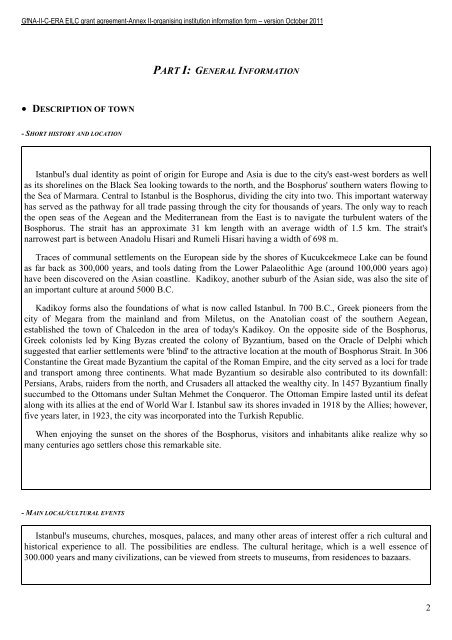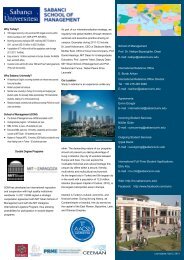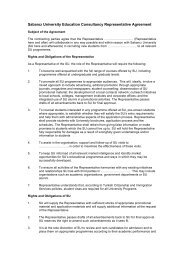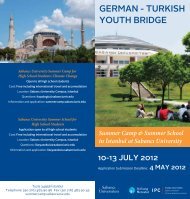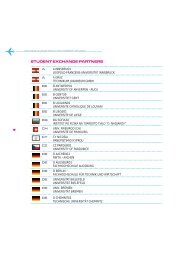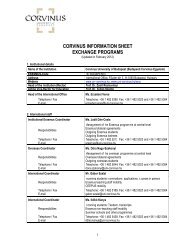ERASMUS INTENSIVE LANGUAGE COURSES - Sabanci University
ERASMUS INTENSIVE LANGUAGE COURSES - Sabanci University
ERASMUS INTENSIVE LANGUAGE COURSES - Sabanci University
Create successful ePaper yourself
Turn your PDF publications into a flip-book with our unique Google optimized e-Paper software.
GfNA-II-C-ERA EILC grant agreement-Annex II-organising institution information form – version October 2011<br />
PART I: GENERAL INFORMATION<br />
DESCRIPTION OF TOWN<br />
- SHORT HISTORY AND LOCATION<br />
Istanbul's dual identity as point of origin for Europe and Asia is due to the city's east-west borders as well<br />
as its shorelines on the Black Sea looking towards to the north, and the Bosphorus' southern waters flowing to<br />
the Sea of Marmara. Central to Istanbul is the Bosphorus, dividing the city into two. This important waterway<br />
has served as the pathway for all trade passing through the city for thousands of years. The only way to reach<br />
the open seas of the Aegean and the Mediterranean from the East is to navigate the turbulent waters of the<br />
Bosphorus. The strait has an approximate 31 km length with an average width of 1.5 km. The strait's<br />
narrowest part is between Anadolu Hisari and Rumeli Hisari having a width of 698 m.<br />
Traces of communal settlements on the European side by the shores of Kucukcekmece Lake can be found<br />
as far back as 300,000 years, and tools dating from the Lower Palaeolithic Age (around 100,000 years ago)<br />
have been discovered on the Asian coastline. Kadikoy, another suburb of the Asian side, was also the site of<br />
an important culture at around 5000 B.C.<br />
Kadikoy forms also the foundations of what is now called Istanbul. In 700 B.C., Greek pioneers from the<br />
city of Megara from the mainland and from Miletus, on the Anatolian coast of the southern Aegean,<br />
established the town of Chalcedon in the area of today's Kadikoy. On the opposite side of the Bosphorus,<br />
Greek colonists led by King Byzas created the colony of Byzantium, based on the Oracle of Delphi which<br />
suggested that earlier settlements were 'blind' to the attractive location at the mouth of Bosphorus Strait. In 306<br />
Constantine the Great made Byzantium the capital of the Roman Empire, and the city served as a loci for trade<br />
and transport among three continents. What made Byzantium so desirable also contributed to its downfall:<br />
Persians, Arabs, raiders from the north, and Crusaders all attacked the wealthy city. In 1457 Byzantium finally<br />
succumbed to the Ottomans under Sultan Mehmet the Conqueror. The Ottoman Empire lasted until its defeat<br />
along with its allies at the end of World War I. Istanbul saw its shores invaded in 1918 by the Allies; however,<br />
five years later, in 1923, the city was incorporated into the Turkish Republic.<br />
When enjoying the sunset on the shores of the Bosphorus, visitors and inhabitants alike realize why so<br />
many centuries ago settlers chose this remarkable site.<br />
- MAIN LOCAL/CULTURAL EVENTS<br />
Istanbul's museums, churches, mosques, palaces, and many other areas of interest offer a rich cultural and<br />
historical experience to all. The possibilities are endless. The cultural heritage, which is a well essence of<br />
300.000 years and many civilizations, can be viewed from streets to museums, from residences to bazaars.<br />
2


